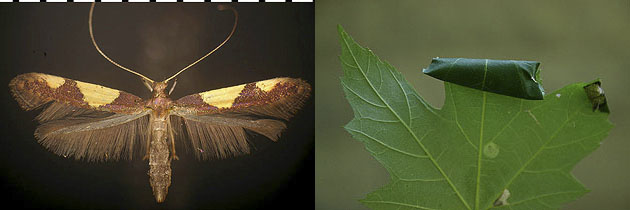
Moths of the genus Caloptilia are, on average, the largest gracillariids found in Illinois, most species being slightly larger than other gracillariines and considerably larger than any of the lithocolletines or phyllocnistines. Adults of most species of Caloptilia are rather brightly colored. Most commonly, the forewing is brown, reddish, or golden (sometimes with violet reflections) and has one or two roughly triangular yellow markings on the costal margin. Larvae begin as leaf miners, often making first a narrow track mine followed by an underside tentiform mine that is superficially similar to that of Phyllonorycter. In later instars of almost all Caloptilia species, however, larvae essentially become leaf rollers, in that they tie a corner of the host leaf asymmetrically into a characteristic "leaf cone" inside which they live and feed. Superficially-similar leaf ties are produced by larvae in certain other groups (for example, Crambidae: Herpetogramma spp.). Also, quite a few species of Tortricidae make transverse leaf rolls on various tree species, but tortricid rolls tend to be more symmetrical (thus cylindrical rather than cone shaped, and relatively more long and narrow) than Caloptilia cones. Mature larvae of Herpetogramma and most of the transversely-leaf-rolling Tortricidae can be readily differentiated from those of Caloptilia (which average about 10mm in length) in that they are considerably larger. Also, the leaf rolls of these non-Caloptilia microleps often can be diagnosed by the presence of straps of silk placed externally along the fold of the cone to help secure it (silken straps are absent on the surface of Caloptilia cones). In some species of Caloptilia, feeding activity is evinced by externally-visible skeletonization of the cone, sometimes in a distinctive pattern. The majority of Caloptilia species feed on woody plants, but a few feed on forbs. The genus is well represented in Illinois.
NOTE: One species, formerly designated as Caloptilia quercinigrella, now is placed in the genus Povolnya (see).
Caloptilia bimaculatella (Fig. 1) feeds on various maples, including silver maple, Acer saccharinum (Sapindaceae).

Figure 1. Caloptilia bimaculatella. Adult, and leaf cone on silver maple, Acer saccharinum (Sapindaceae).
Caloptilia sp. (Fig. 2) was reared from a typical leaf cone on sugar maple, Acer saccharum (Sapindaceae).
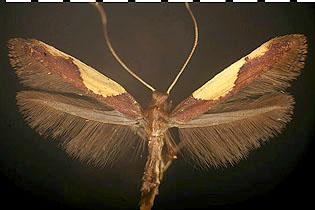
Figure 2. Caloptilia sp. Adult, reared from a leaf cone on sugar maple, Acer saccharum (Sapindaceae).
The larva of Caloptilia packardella (Fig. 3) makes a typical leaf cone on sugar maple. There are at least two generations per year in Illinois.
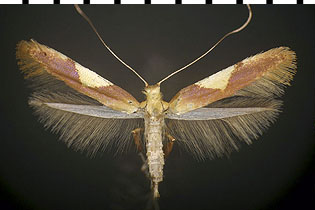
Figure 3. Caloptilia packardella. Adult, reared from sugar maple, Acer saccharum (Sapindaceae).
Caloptilia umbratella (Fig. 4) feeds on sugar maple, Acer saccharum (Sapindaceae). The leaf cones of this species tend to be found from mid- to late summer, over a large enough range of dates that two generations could be indicated.
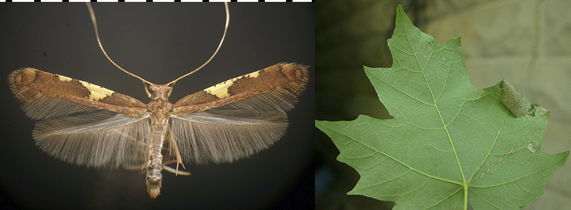
Figure 4. Caloptilia umbratella. Adult, and leaf cone on sugar maple, Acer saccharum (Sapindaceae).
Caloptilia sp., Ribes feeder (Fig. 5), feeds on woodland-occurring gooseberry, Ribes sp. (Grossulariaceae). It is externally very similar to C. umbratella, but male genital morphology of the two moths clearly indicates that they represent two different species. It remains to be determined whether the remarkable similarity in the coloration and pattern of markings of the forewings of these two moths represents independent derivation or reflects recent common ancestry.
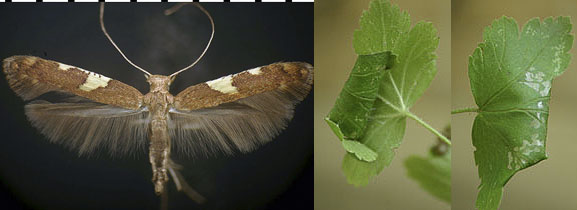
Figure 5. Caloptilia sp., Ribes feeder. Adult, and leaf cone on gooseberry, Ribes sp. (Grossulariaceae). The pattern of feeding damage seen in the right-hand panel is characteristic of this species.
Caloptilia negundella (Fig. 6) feeds on box elder, Acer negundo (Sapindaceae).
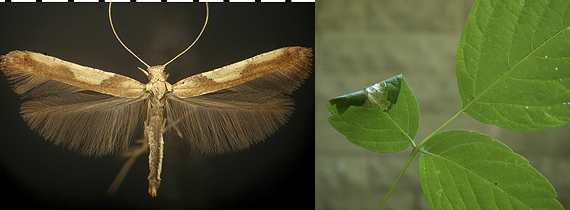
Figure 6. Caloptilia negundella. Adult, and leaf cone on box elder, Acer negundo (Sapindaceae).
This Caloptilia sp. (Fig. 7) feeds on Ohio buckeye, Aesculus glabra (Sapindaceae). This Caloptilia is indistinguishable from C. negundella on male and female genital morphology, as well as on coloration.
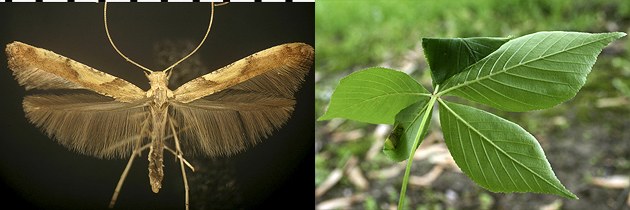
Figure 7. Caloptilia sp., buckeye feeder. Adult, and leaf cone on Ohio buckeye, Aesculus glabra (Sapindaceae).
Caloptilia stigmatella (Fig. 8) feeds on cottonwood, Populus deltoides (Salicaceae) in central Illinois. It is also recorded from willow, Salix sp. (Salicaceae).
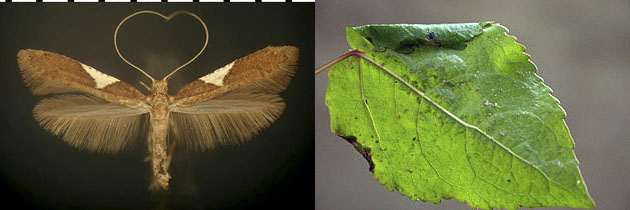
Figure 8. Caloptilia stigmatella. Adult, and leaf cone on cottonwood (Populus deltoides).
Caloptilia belfragella (Fig. 9) feeds on dogwood, Cornus sp. (Cornaceae). In its early stages, the larva feeds inside an underside tentiform mine that resembles the mine of Phyllonorycter. The habit of the later-stage larva of C. belfragella is a bit unusual in that, in most cases, an entire dogwood leaf is evenly rolled lengthwise (as shown), although some individuals do roll a transverse cone as is typical for the genus. This moth was long referred to as C. belfrageella, but belfragella is the correct spelling of the species name, as pointed out by De Prins and De Prins (2005).
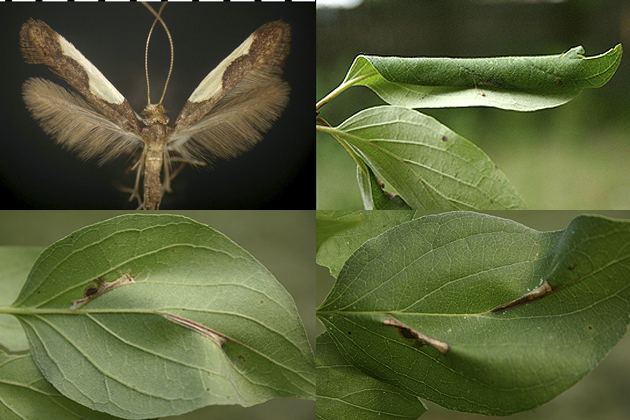
Figure 9. Caloptilia belfragella. Top: adult, and leaf roll of mature larva on dogwood, Cornus sp. (Cornaceae); bottom: underside and upperside views of the tentiform mines of two early-stage C. belfragella larvae.
Caloptilia blandella (Fig. 10) feeds on black walnut, Juglans nigra (Juglandaceae). The leaf cone of this species is smaller than usual for the genus. It involves only one fold of the host leaflet, and therefore extensive skeletonization can be seen on the exterior of the fold. Often, the fold is located on the margin of the leaflet rather than at the apex, in which case it resembles the marginal leaf folds that are made typically by microlep larvae of other families (e.g., Tortricidae).
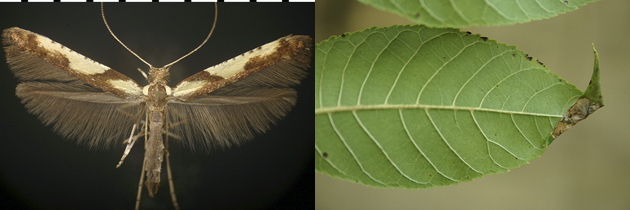
Figure 10. Caloptilia blandella. Adult, and leaf cone on black walnut, Juglans nigra (Juglandaceae).
Caloptilia ostryaeella (Fig. 11) feeds on hop hornbeam, Ostrya virginiana (Betulaceae). The adult is somewhat similar in appearance to C. blandella (covered immediately above, for convenience of comparison), but differs in having the dorsum of the thorax entirely yellow (brown with yellow "shoulder lappets" in C. blandella) and in having the yellow area at the base of the forewing extending to the hind margin of the wing (yellow area not reaching hind margin in C. blandella).
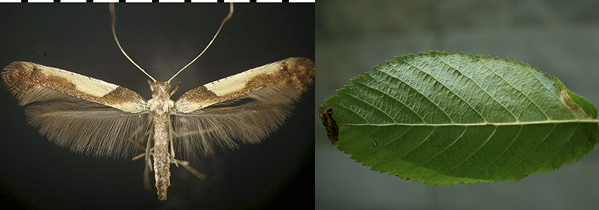
Figure 11. Caloptilia ostryaeella. Adult, and leaf cone on hop hornbeam, Ostrya virginiana (Betulaceae). The Caloptilia leaf cone is at the apex of the leaf (this small cone is probably an abortive effort; the leaf cone in this species, when fully realized, is about the same size as shown for most other Caloptilia species on this page). Note that there also is a leaf mine of a lithocolletine gracillariid, Phyllonorycter sp., near the base of the leaf.
Caloptilia superbifrontella (Fig. 12) feeds in a typical leaf cone on witch-hazel, Hamamelis virginiana (Hamamelidaceae); in central Illinois, active larval damage occurs during the first week of June.
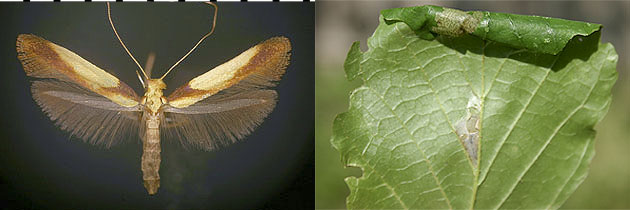
Figure 12. Caloptilia superbifrontella. Adult, and leaf cone on witch-hazel, Hamamelis virginiana (Hamamelidaceae). Below the leaf cone is seen the mining damage that was made by this larva during its early development.
Caloptilia rhoifoliella (Fig. 13) feeds on sumac, Rhus sp. (Anacardiaceae).
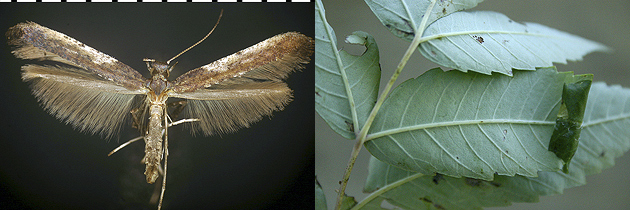
Figure 13. Caloptilia rhoifoliella. Adult, and leaf cone on sumac, Rhus (Anacardiaceae).
Caloptilia sassafrasella (Fig. 14) feeds on sassafras, Sassafras albida (Lauraceae).
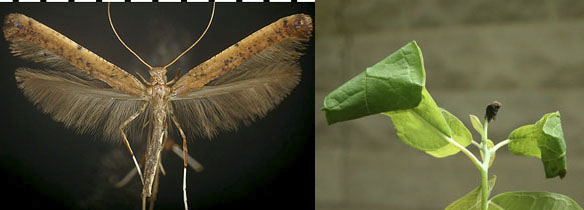
Figure 14. Caloptilia sassafrasella. Adult, and leaf cones on sassafras, Sassafras albida (Lauraceae).
Caloptilia violacella (Fig. 15) feeds on tick trefoil, Desmodium sp. (Fabaceae), usually on species that occur in open areas.
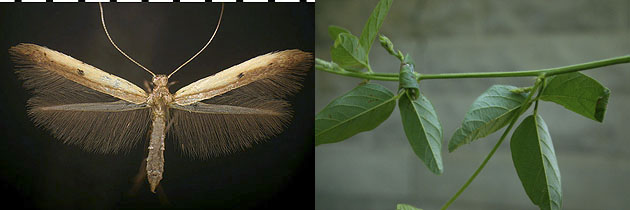
Figure 15. Caloptilia violacella. Adult, and leaf cones on tick trefoil, Desmodium sp. (Fabaceae).
Caloptilia fraxinella (Fig. 16) forms a typical leaf cone on ash, Fraxinus sp. (Oleaceae), beginning in early July in central Illinois, where there appears to be one generation per year. The species is atypical for the genus in that the larva pupates within the leaf cone, in a suspended silken cocoon. The forewing coloration of uniform, mottled gray is unusual for the genus; however, in typical Caloptilia fashion, it retains at 1/3 the length of the costa a trace of the angled dark patch which, in some Caloptilia species that have the yellow costal patch(es), is seen to precede the yellow area.
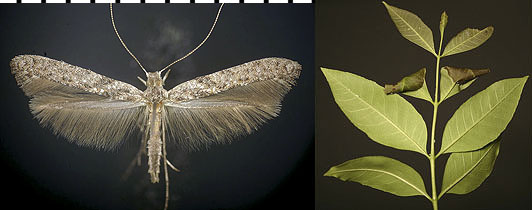
Figure 16. Caloptilia fraxinella. Adult, and leaf cones on ash, Fraxinus sp. (Oleaceae).
Caloptilia scutellariella (Fig. 17) is atypical for the genus, both in adult coloration (uniform gray, with a faint hint of pale strigils on the costal margin) and in larval feeding mode. On Scutellaria ovata, the larva forms a unique white full-depth blotch mine in mid-to late July, and there is only one generation per year, whereas on S. incana, the larva forms a puffy underside mine (similar to that of Parectopa plantaginisella on Erigeron), and there are multiple continuous generations throughout the year, with mature larvae appearing from late May through late September. Unlike a typical Caloptilia larva, C. scutellariella remains inside the leaf mine throughout its entire larval life, never leaving the mine to form a "leaf cone" as is otherwise characteristic of the genus. However, when the larva finishes feeding, it displays typical Caloptilia behavior by leaving the mine and spinning a small cocoon in which it pupates.
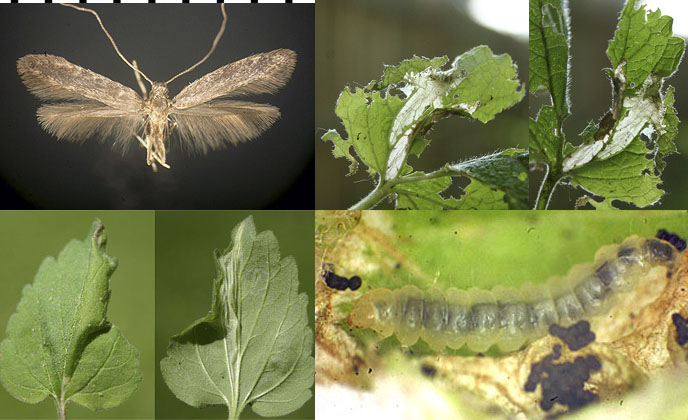
Figure 17. Caloptilia scutellariella. Top: left, adult; right, leaf mine on Scutellaria ovata (Lamiaceae). At the central-Illinois site where these mines were collected, by mid-July, the leaves of S. ovata are rendered quite ragged (as seen in this image) by the feeding activity of an undetermined beetle. This apparently has no adverse effect on larvae of C. scutellariella; bottom: left, upperside and underside of leaf mine on Scutellaria incana; right, larva from leaf mine on S. incana.
Caloptilia murtfeldtella (Fig. 18) is easily the largest gracillariid that occurs in Illinois. Braun (1922) gave a detailed account of the biology. The larva feeds on Penstemon spp. (Scrophulariaceae), usually P. laevigatus but also P. hirsutus and possibly others. The larval feeding mode is unusual for Caloptilia in that the larva of C. murtfeldtella induces and lives inside a stem gall; one or more galls may occur per stem, but only one larva inhabits each gall. The galls occur low on the stem, usually from ground level to a few inches above. The gall reaches its full size in late May or early June, at which time the larva is still in an early stage of development. The larva continues feeding throughout summer, until finally, in early September, it chews a 2-3mm wide tunnel outwardly through almost the entire wall of the gall, leaving only the external epidermal layer as a round, externally-visible "emergence window"; it then spins its cocoon, one end of which is anchored to the bottom end of the gall, the other end being spun so as to encircle the emergence window. It then pupates with its head end near the emergence window, and finally (mid- to late September), it pushes out through the window as a pupa then emerges as an adult moth, leaving behind the protruded pupal exuvium as is typical for the genus. Winter is passed in the adult stage.
In Illinois and Indiana, pristine (i.e., recently emerged, not overwintered) adults of C. murtfeldtella routinely are observed in mid- to late June. This appears to indicate that at least some individuals of the larval generation that begins in May develop straightaway to pupation and adult emergence, rather than undergoing the prolonged larval development described above.

Figure 18. Caloptilia murtfeldtella. Top: left, adult; right, galls induced by two larvae on a stem of Penstemon sp. (Scrophulariaceae); middle: left, gall opened, revealing an early-stage larva (early June, central Illinois); right, closeup of early-stage larva; bottom: full-term gall (late September, central Illinois) from which an adult C murtfeldtella has emerged, leaving behind the protruded pupal exuvium (note also the presence of several hardshell scale insects on the exterior of the gall); right, the gall in the left-hand panel, opened, to reveal the interior cocoon from which the pupal exuvium was protruded.